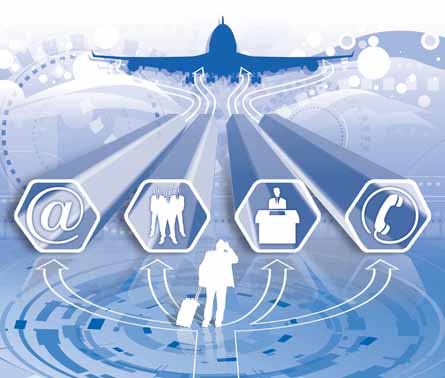US carriers have won price concessions after a year of tough negotiations with the global distribution systems
In the long war between North America’s cost-pressured airlines and the primary sales channel to their customer, the global distribution systems (GDS), the attacks and counterattacks have died down after months of battle.
The carriers and their distributors have signed peace pacts that will give a grace period of four years or more. However, neither side is basking in glory. And the peace is likely to be far from tranquil as both sides prepare for the next battle.
 © Gareth Burgess |
|---|
Spiralling GDS costs have long been in the sights of airline managers pushing for deeper cost cuts. Not so long ago, bookings made by travel agents via the GDS providers (GDSs) made up over three-quarters of all travel. The rise of airlines using direct online channels dramatically eroded this market power.
A deregulated US market, an environment where guaranteed annual price rises were no longer acceptable and new web-based technologies that promised to replace the GDSs posed new questions for the distribution giants. Carriers demanded they answer these questions with cost cutting.
The outcome of the clash was set late last summer when the airlines squeezed new deals out of their GDSs in a set of new contracts. As Gordon Locke, vice-president of airline and marketing strategy at Sabre Travel Network, a major GDS, says: “Certainly, it was a set of new economics in which the airlines won their case to lower their costs.”
The GDSs and the travel agencies had no choice but to be aware of the dilemma airlines faced. John Slater, managing director of distribution and e-commerce at Continental Airlines explains: “We opened our kimono to them [travel agents and GDSs] to show them the situation we were in.”
Nuclear option
At one point, Slater and other airline figures were talking openly about the nuclear option - the possibility that one of the majors would simply not renew its contracts with all the GDSs. At a single sweep, such a move would have prevented a whole raft of travel agents booking their customers on that carrier.
The airlines’ major objection centred on an expensive and complex set of incentives they gave to the travel agents through the GDSs. The incentives are designed to keep the agents loyal to a carrier and are on top of basic GDS fees. To force a change to this arcane system, airlines threatened to impose charges to agents of their own and to keep back their best fares. The US majors were prepared to impose $3.50 per-segment charges to agents for bookings.
One of the most vocal airline objectors, American Airlines senior vice-president of global sales David Cush says: “We were serious. It wasn’t a threat. But cooler heads prevailed and we got the cost of a GDS booking to within a reasonable and acceptable gap of the cost of doing it online in-house. But that may not be the case for all time.”
In essence, the compromise reached saw the GDSs reducing the incentives they pay to agencies and other customers for booking through them, and in return promising full airline content. For their part airlines were able to reduce what they pay to the GDSs, even though incentives are not yet eliminated entirely.
To protect their revenue stream, the GDSs created new policies for travel agencies and corporate clients. These sheltered the travel agents from airline fees. In return the agent either pays the GDSs or accepts a much lower GDS incentive. Essentially the US travel agent community is opting into a new economic formula, importing a model pioneered by British Airways and Qantas.
Sabre began this movement in the USA, with Galileo, Worldspan and Amadeus following suit with similar programmes of their own. Many travel agencies believed they had no choice but to “opt in” to the new arrangements. The GDSs say agents have overwhelmingly signed, with Sabre claiming over 99% participation, while Travelport’s Galileo claims 100% acceptance.
For the carriers the compromise produced savings. Cush estimates transaction costs will fall by as much as 50%. Slater says that for a domestic booking, Continental’s costs have dropped to between $7.50-8 a booking, down from about $13 before.
For Slater, the compromises proved some “important points about ownership of data and the value of the content”. American, whose signing of a five-year deal with Sabre was a major industry event, “can live with what we got until the next round”, says Cush.
So can the GDSs. “The GDSs and the agencies got what they so deeply needed and wanted: a guarantee of full content. We got stability,” says Galileo’s Jean Collier, senior director of airline services in the Americas.
She says the importance of full content “simply cannot be overemphasised”. Without it, agents and corporate travel departments faced fragmentation. They have a real need to search multiple sources for full fare, seat or room availability to meet a clients’ needs quickly.
The message on full content is driven home by David Jones, executive vice-president commercial of Amadeus. “Perhaps if the agencies hadn’t insisted to the GDSs as much as they did on full content they might have ended up paying less. One thing we will be seeing is more of a focus on what the really relevant content is. After all, if you insist on all content you give more power to the people who control that content.”
Sabre’s Locke adds that an important factor was that the opt-in solutions ensured stability. The landscape is “more secure and more stable, allowing the effective forecast of availability of content and seamlessness”, he says.
Although the airlines have made more ground on their distribution costs, there are no clear-cut winners or losers this time around. However, some believe the larger travel agents are becoming stronger. These groups have always been critical of airlines for their power in booking business travel.
Balance of power
Henry Harteveldt, the San Francisco-based Forrester Research analyst, says, airline distribution “is no longer a two-way balance of power but a complex ménage a trois that shifts based on the economy and airline industry dynamics. As such, the large travel agencies play an increasingly major role. The GDSs are at the mercy of two sets of customers, the airlines and the agencies.”
 |
|---|
“We got the cost of a GDS booking to within a reasonable gap of the cost of doing it online in house.” David Cush, American Airlines |
Harteveldt cites a recent conflict between online agent Expedia and American Airlines as a demonstration of the importance of full content to the distributors and of full access to distributors to the airlines. In January a dispute between the two over economics came to a head when most of American’s higher-yielding fares disappeared from Expedia. Harteveldt says: “No network or international carrier can be absent from Expedia because their clout and penetration is too great.”
The two sides traded public charges, with American saying it pulled the fares because of an economic dispute with Expedia. The online player said it decided to exclude American from its databases. At the time, Expedia was shifting much of its GDS processing away from Worldspan to Sabre and some observers saw the move as a pressure play to win better terms from American as it made the shift.
Competing for control
By February, Expedia and American had restored their working relationship, but as Richard Eastman, distribution industry veteran and head of the California-based Eastman Group says: “This is a good example of today’s travel distribution world as a giant travel agent competes with a giant airline for control of distribution. Expedia is now as powerful as the GDSs were.”
This new force includes mega-agencies such as CWT, The Carlson Wagonlit Group, or AmEx, the American Express Travel Services Group. Both have developed smart technologies that let them use GDS services at a lower cost. It is American Express that has made the highest-profile advance with its so-called TravelBahn Distribution Solution.
This is proprietary technology that its architect, AmEx senior vice-president for global supplier relations Andrew Winterton, says is a direct way into airline content but does not eliminate the GDS. “It allows us to control the relationship from our side and so AmEx was able to protect our customers from the new surcharges,” he says.
American was the first to sign up to let AmEx distribute its fares through TravelBahnDS, and Continental and United have joined too. So have most AmEx corporate customers. Winterton says TravelBahn is “neither GDS-dependent nor independent of the GDS”.
“With corporate travel, enough of the big players have modified their front-end technologies that they’re adapting to the new economics,” says Cush of American. “This is something that the airlines welcome. The corporate travel agencies and departments have the expertise in managing ‘compliance’ - making sure that their employees obey travel rules and use preferred suppliers.” As Continental’s Slater puts it: “That’s what they’re good at, that’s where their expertise is and we have no intention of trying to get into that field. We sell airline seats.”
That is perhaps an understatement. Given the leverage they have gained as the GDSs and their customers slug it out, the airlines can “sit pretty for now”, says Harteveldt, and bring the GDSs back to the bargaining table at an advantage.
For instance, Kevin Healy, vice-president planning at AirTran Airways, who is in charge of distribution for the growing low-cost carrier, says AirTran had withdrawn from most of its GDS relationships but signed up again “after they came to us. And they knew they had to offer better economics.” Healy believes the balance of power is shifting toward the carriers, putting the airlines and the GDSs “at a stalemate at worst”.
Still, few US carriers, low-fare or legacy, truly believe they can thrive without the GDSs at this stage of the game. One low-cost player that tried to, JetBlue Airways, returned in August to the GDSs that it had abandoned just a year or so before. But, much like AirTran, it did so on its own terms.
Low-cost distribution
JetBlue’s distribution director Noreen Courtney-Wilds explains the decision to return in both economic and strategic terms: “They [the GDSs] came back to us offering a lot more flexibility both on what they gave us and on the economics. Before, you had a limited number of fares you could display at a given level [of GDS participation] and they had a take-it-or-leave-it approach. You would have to pay a lot more to go up to the next level.
“They got a lot more flexible,” says Courtney-Wilds. “As we brought on the new smaller Embraer jets into new markets, we needed the reach the GDSs give into corporate markets and clients where we could get higher yielding traffic. With a big Airbus, you can fill it up with low fares and make money but with the smaller planes you have to seek out the kind of customer the GDS gets.” JetBlue expects to see as much as $100 million in new revenues this year through its GDS contracts.
 |
|---|
“GDSs just were not able to sell all of our options” Marc Rosenburg, Air Canada |
If airlines have gained more power, what is the way forward? Few airline executives are as exuberant as they were just a few years ago about the prospects of taking their distribution business in house. As Harteveldt says: “The airlines can talk as much as they want about their dotcom or their portals, but these will never get much more than one-third of the total volume and of that one-third, 80% or more is from their own sites, much of it in domestic leisure business with lower-yielding fares. The direct connects that they talked about so much just a few years back will never be much more than 5% of volume.”
Airline executives say that their own sites may have an upper limit but are not sure they have reached it quite yet. American’s Cush believes that in some regions, internet penetration rates lag and that payment solutions need to catch up. At both US Airways and American, web sales are growing at double digit rates annually, but there are limits.
Travis Christ, vice-president, sales and marketing of US Airways, says: “Developing your own airline website is far more complex and far more expensive than you would think, and among the other challenges is finding the right programmers at a time when there is tremendous competition for highly skilled people. In Phoenix, we are lucky because a lot of people want to live and work here but not all airlines can say that. Some people shy away from working for an airline.”
The airlines also have the advantage of new technology on their side. The so called GNEs, now more modestly dubbed Alternative Content Providers, may have oversold themselves as replacements for the GDSs but they are still working closely with the airlines. “We play a long game. This business is all about building relationships,” says Gianni Marostica, chief commercial officer of one Alternative Content Provider, ITA Software.
ITA is building an entirely new host computing system for Air Canada, while another player, G2 SwitchWorks, is doing work for United Airlines and for mega-travel agencies.
Unbundled selling
 |
|---|
“Developing your own airline website is far more complex than you would think” Travis Christ, US Airways |
So where will airlines turn if their own websites will never fully replace the GDS? American’s Cush believes the next big hurdle is an “a la carte” style of unbundled selling, as pioneered by Air Canada. The idea is for airlines to individually sell selected services like preferred seating.
This “creates a technological hurdle for the GDSs,” says Cush, because they need pressure from a mega carrier to offer an unbundled solution. However, “Air Canada is not big enough in the States,” he says, to force such a change.
American, which can force the GDSs to adopt this model in the US, is looking closely at unbundling some services. “When a critical mass is achieved over here and if the GDSs don’t push it to the front burner they will be at a competitive disadvantage,” says Cush. “It is getting us to where we probably would have been already had we not been regulated for all those years.”
At Air Canada, the executive who designed the technology to get unbundled pricing out to the customers, Marc Rosenberg, agrees. Rosenberg, vice-president for sales and product distribution for the airline, says: “Joke all you want about charging for an aisle seat or to go to the bathroom, but if you have to compete on price you have to do these things. GDSs just were not able to sell all of our options. They had no problem booking and selling our cheapest fare, but their legacy systems just aren’t nimble enough to be changed.”
And it is in this area that further changes to the airline distribution dynamic will occur. According to Rosenberg: “The next round of airline/GDS skirmishes will not be a question of economics, but it will be a question of technology and I think they will respond. I wish it were sooner.”
Airline Distribution conference 2007The Airline Distribution conference road show is making its annual stop to debate the complex and fast-moving world of selling and distributing air tickets in Fort Lauderdale from 24-26 April.Organised by Airline Business and UATP, the airline-owned corporate travel credit card company, Airline Distribution has become the industry’s leading platform for senior executives from airlines, the global distribution systems, payment suppliers and other elements of the travel distribution chain to unpick the driving forces in this sector.Carriers have long criticised high distribution costs but in the past found them frustratingly hard to peg back. That is changing, especially in North America and Europe. Network carriers have won new deals with the global distribution systems (GDSs) that lower their transaction costs (as this feature explains).In the executive session at Airline Distribution, Travis Christ of US Airways and Deborah Dickens of British Airways will explain how they have been attacking their cost of sales.Carriers from Latin America, led by Giancarlo Taliente, senior director of distribution at Panama’s Copa Airlines, will also take centre stage at the event. In league with the Latin American Airlines Association ALTA, the region’s carriers are studying how to make progress collectively on their GDS costs.ALTA members spend about twice as much on selling and distributing their seats compared with those in North America, the association estimates. Latin carriers want to achieve the reductions their peers have achieved, and fast.Two regular sessions at Airline Distribution return this year: one looking at payment models and the other examining distribution deals. Senior executives from Delta Air Lines, Galileo, IATA, ITA Software, Sabre and SN Brussels will be represented on these interactive panels.The topics of winning greater revenues via the web and using the internet as a sales and marketing tool will be popular too. The latter will be led by noted Forrester Research analyst Henry Harteveldt. The new revenue streams panel features Air Canada’s Marc Rosenberg, Radosław Dutkowski of LOT Polish Airlines and Cormac Whelan of Datalex.This year’s Florida event follows on the heels of a highly successful event in Dublin in 2006 and Bangkok in 2005. Over 250 specialists from the around the globe are expected to attend. Keynote presentations are being given by Continental Airlines president Jeff Smisek and Duane Futch, global travel services director of Wal-Mart.For booking details and the full conference programme, visit: www.uatp.com/distribution2007  |
|---|
Source: Airline Business






















